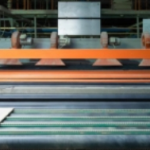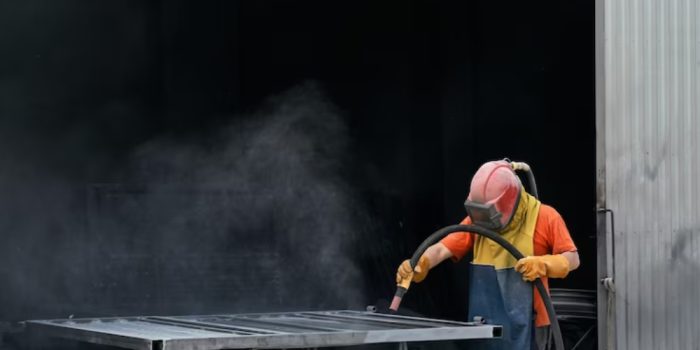
Organized warehouses– 5 benefits of having proper storage systems
June 28, 2023
8 Benefits of Choosing Laser Cutting for Metal Sheet Fabrication Projects
July 21, 2023When it comes to surface finishing and coating options, the possibilities are endless. But powder coating remains a popular choice in various industries. The technique was first introduced in the United States in the 1960s and has since advanced to incorporate new technologies.
If you want to know everything about powder coating and why it has gained a great deal of momentum over the past decade, this guide to powder coating is for you.
This blog explains what powder coating is, how to powder coat items, how the coating works, and much more.
What is Powder Coating?
Powder coating involves the application of paint to components using advanced techniques. The powder coating process involves the application of finely ground pigment particles and resin utilizing an electrostatic process. The item is then cured with heat or UV light.
The process helps create a smooth, consistent finish that is much better than traditional paint finishes. Moreover, it is available in a variety of coatings and colors. It can be applied to various surfaces, such as steel, plastic, and concrete. That means it is an ideal option for countless industries.
A high-quality powder coating layer is quite resistant to corrosion. In fact, the protective surface finish helps enhance the sturdiness and durability of the substance it is applied onto. That makes powder-coated items more suitable for indoor and outdoor environments.
An In-Depth Guide to the Powder Coating Process
The powder coating process consists of three stages:
1. Surface Preparation Stage
Before the powder coating material can be applied, the surface needs to be cleaned to remove impurities such as dust, dirt, and debris. If the surface is not prepared properly, the powder finish may not adhere to the surface and compromise the quality of the final finish.
The preparation procedure can vary depending on the material of the product. But generally, this stage consists of cleaning, rinsing, etching, blasting, and drying. And if the surface has oil, grease, or other residues, the item can be dipped in tanks containing a weak alkali or detergent. Sometimes, these items are also sprayed with hot water, steam, or other pretreatment solutions to prepare the surface. And if a part is to remain uncoated, masking dots can be applied to the surface during this stage.
2. Coating Application Stage
There are two kinds of powder coating materials. So the application method will differ depending on the type of coating being applied.
- Electrostatic Deposition (ESD)
In this process, the liquidized coating powder is applied to a product using an electrostatic spray gun. This equipment electrically charges the powder as it is applied to the electrically grounded part. The overspray material is collected by the recovery and retrieval system to be reused for other coating applications.
- Fluidized Bed Powder Coating
In this process, preheated parts are dipped into the coating powder in a fluidized bed. The coating particles then fuse to the part, creating a smooth, even finish.
3. Curing Stage
The curing process allows the powdered coating to harden. Once this surface forms, the part will be more durable and resistant to wear and tear in any application.
The curing process can vary depending on the type of method used to apply the powder coating material.
In ESD, the coated parts are cured in a powder curing oven with temperatures between 325 – 450 °F. The powdered coating particles melt because of the heat, creating a uniform film over the part. The curing time depends on the size, shape, and thickness of the part. But typically, it can take about ten minutes to about an hour.
For items coated in a fluidized bed process, the parts are heated in the oven before the application stage. So when the heated parts are immersed in the powdered coating material, the particles melt upon contact and form a coating on the surface of the parts.Once the coated item cools down, it can be assembled or packed for shipping.
How Does Powder Coating Work?
The material used in powder coatings consists of several substances, such as pigments, flow modifiers, resin, additives, curing agents, etc. They all work together to form a strong, protective coat on top of the item and give it a smooth polished look.
However, in order to adhere to the surface of the item, the powder coating needs to be ionized before it is cured. When exposed to heat, the chemical bonds are solidified, giving powder coating the protective capabilities and strength it is renowned for. Additional powder coating layers can also be applied to increase the thickness of the coat, thereby creating a finish that lasts longer and offers more protection.
How Long Will the Coating Last?
With proper care, powder coats can last about 15 – 20 years. But items that are used consistently and endure a lot of impact or scratches can damage the coating.
Other factors can also influence how long the powder coating lasts, such as the type of powder coating, how carefully the surface was prepared, the coating’s thickness, the environment the coated part is exposed to, the amount of exposure to UV light, etc.
Furthermore, the type of elements used in the powder coatings can also impact the lifespan of the coat. For instance, coatings with epoxy are more suitable for indoor items. Exposing them to a harsh outdoor environment can cause the coating to break down quickly.
Benefits of Powder Coatings
Before we end this guide to powder coating, let’s highlight just a few of the benefits. There are a lot of advantages to powder coating finishes. For instance, they make an item more durable by helping to protect corrosive materials like water and chemicals to react with the surface. That is why it protects parts from corrosion.
But besides this, powder coatings allow companies to cost-effectively create versatile products by altering the color, texture, and finish of the same item. Due to this quality, many industries utilize powder coating products, such as automobiles, electronics, architecture, etc.
But this is only the tip of the iceberg. Dozens more benefits are making it a popular choice in manufacturing applications.
Final Thoughts
This guide to powder coating describes how these finishes have revolutionized the manufacturing world. Their resilience, aesthetic versatility, and economical process make them a great option for many industries.
However, the key to a great finish lies in partnering with the right powder coating service provider. This is where we come in. Midwest Distribution llc is a reputable company that offers powder coating services, guaranteeing excellent durability and high-quality finish.
Contact one of our company representatives to learn more about our powder coating services.

